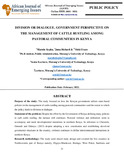| dc.description.abstract | Purpose of the study: The study focused on how the Kenyan government utilizes state-based policies in the management of cattle rustling among pastoral communities and the extent to which the policy leads to division or dialogue.
Statementof the problem: Despite the effort by the Government of Kenya defining many policies to curb cattle rustling, the menace still continues. Pastoral violence and militarism seemto accompany and mark developmental transitions in northern Kenya. In reference to Cheserek, Omondiand Odenyo, (2013) despite adopting a new constitution and establishing devolved governance structures in the country, violence continues to define intercommunal interactions in northern Kenya.
Research methodology: The study used mixed study design and covered the five counties in North western part of Kenyanamely, Elgeyo-Marakwet, Baringo, West Pokot, Samburu and with a population of 2,980,035 residents. The sample size of the population is 384, which was determined by the deployment of Krejcie, R.V., & Morgan, D.W. table.
Results of the study: The results indicated the government has succeeded in the following policies, able to control cattle raids in the region(72% agreement), reduced rampant gun ownership(85% agreement), enacted laws to deter cattle rustling(72% agreement), offered education on good farming (72% agreement) and encouraged community intermarriages(average success of 55% agreement). However, the government has not succeeded in the following policies; introduction of agricultural farming to reduced rustling had only 10% success, giving scholarships had 43% success, providing employment after school had only 15% success, supporting locals to access loans to own permanent structures had a low success of 17%, supporting locals to own farm implements also had a low success (14%), and offering locals market to their produce had a low success of 33%.
Conclusion:The study concludedthat the GoK has been able to put framework policies to control cattle rustling menace. However,the implementation of such policies have not succeeded in impacting the positive changes envisaged by the GoK. This implies that the GoK has not been able to bring dialogue among the cattle rustling communities hence division exists among the communities thus continued menace.
Recommendations: GoK should turn to other non-Government agencies to implement its policies such as the churches, NGOs. To enable successful management decision-making, conventional institutions should play a more decisive role and integrate more robustly with the government. Local governments should legitimize and promote neighborhood associations. County governments shouldcollaborate with local community organizations, which requires additional support from the federal government and at the policyand planning levels. Donors, governments, and projects should strengthen and empower such institutions rather than supplanting and alienating them. The County government's powers and responsibilities should be defined in legislation, and there should be legal mechanisms for evaluating the quality of local government cooperation with traditional institutions. | en_US |

